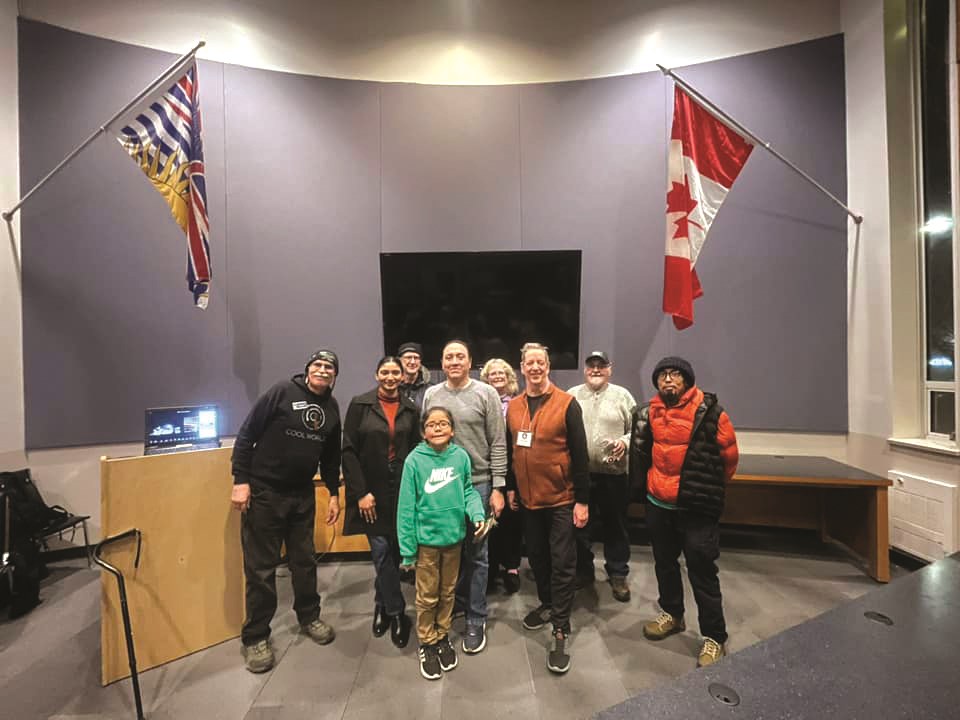Astronomers from the Sunshine Coast have opened a dialogue with members of the shíshálh Nation to restore Indigenous knowledge of the skies.
“I want to see people get their skies back,” said Charles Ennis, a director of Sunshine Coast Centre of the Royal Astronomical Society of Canada, and the national organization’s former president.
Ennis is a retired law enforcement investigator. He compares the search for cultural information about star patterns (called asterisms) to detective work. “It’s a reconciliation process,” he added, “the World Asterism Project is about reconciliation.”
At a December meeting of the local astronomical society, representatives of the shíshálh Nation including lhe hiwus yalxwemult (Chief Lenora Joe) gathered with astronomers for a presentation by Shandin Pete, a UBC science educator whose heritage stems from the Bitterroot band of the Salish Nation in Montana and Diné from the Beshbihtoh Valley in Arizona.
Pete reconstructs Salish asterisms through painstaking research.
“I always wondered about the stars since I was a little kid,” said Pete. “But some of our older people had forgotten some of the things about them.”
Pete discussed three groupings of stars that he found are connected to traditional creation stories of the Salish people. “Moving here to Vancouver, I started to understand that the stories of our relatives here could add little pieces to the story,” he explained, “and that make it more full and more understandable.”
In Salish stories, part of the Orion constellation is viewed as The Canoe. Pleiades, a star cluster 444 light years from Earth, is known as Cast Away Children. Stars in the Auriga formation, which other cultures called The Charioteer, is known by Salish sky-watchers as the Camas Baking Pit.
The Royal Astronomical Society of Canada launched its World Asterism Project in 2021. By interviewing Elders and consulting records of 570 distinct cultures, the group has recorded traditional Indigenous knowledge of over 13,000 star formations. The database now includes 1,602 names for the sun, moon, and planets.
Sarah Joe, of the shíshálh Nation, prompted Pete to share a song that embodies traditional knowledge. After he sang a verse that proffered peace between buffalo-hunting tribes, Joe shared a song with unique ties to the skies of the shíshálh swiya (homeland).
“My song is called Follow the Moon,” Joe said. “I sing it for my grandmother because when my grandmother is on her canoe heading up the inlet, she’s looking at the Grandmother Moon and praying. That’s the inspiration for my song.”
Ennis said that the astronomical society has observed a surge of interest from shíshálh citizens over the past year. “We’re starting to get engagement and a dialogue going back and forth,” he said. “My job is to find the stars and help people put the stories back in the sky.”
When the World Asterism Project was first proposed, some astronomers were skeptical. “The guy that was the biggest critic,” recalled Ennis, “he said, ‘You’ll never succeed. It’s too big a task.’ And now he’s going, ‘How did you do that?’”
The astronomical society’s research committee has exchanged data with partner organizations as distant as Belarus, Australia, South Africa, and Argentina.
In some Indigenous cultures where sky knowledge has been lost, traditional languages are being used to rename stars and their formations.
“This is what our ancestors did,” said Ennis. “They stood around the fire and they pointed to the sky and said, here’s the story.”
For more information about initiatives of the Sunshine Coast Centre of the Royal Astronomical Society of Canada (including observatory hours), browse to www.coastastronomy.ca.



